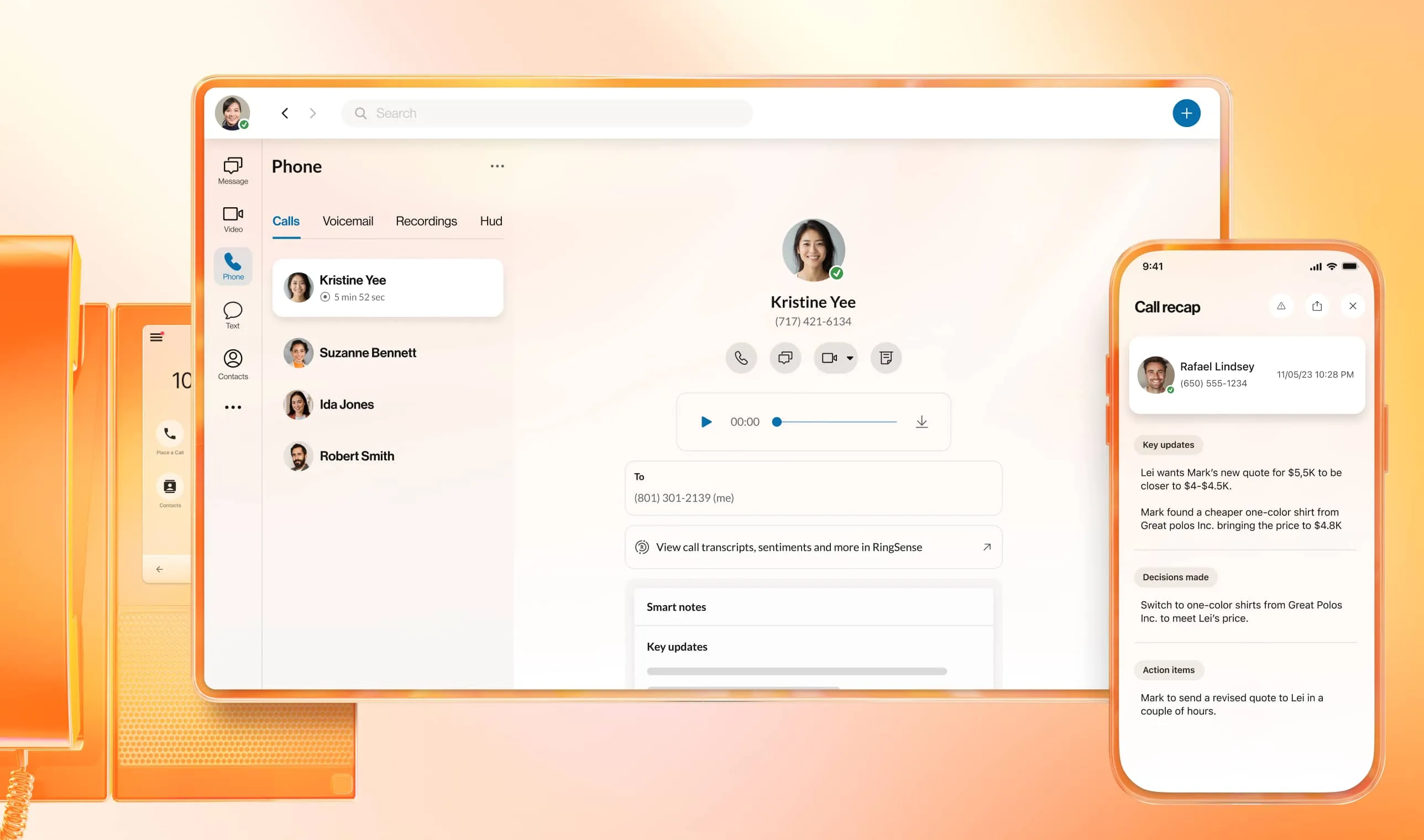Digital customer engagement
Digital customer engagement is key to taking a customer-centric approach and delivering seamless experiences across channels. With RingCentral RingCX you can meet customers where they are across 20+ digital channels including live chat, SMS, and more.

What is customer engagement?
A simple customer engagement definition is that it’s everything you do to interact and connect with your customers. Every touchpoint a consumer has with you plays a part in either strengthening or weakening customer engagement—depending on how satisfied that customer is with their experience.

What is digital customer engagement?
Digital customer engagement is an important subset of overall customer engagement. It’s the sum total of all the interactions customers have with your brand digitally.
Sometimes also known as digital consumer engagement, it represents the holistic experience of any customer who interacts with your business on your website, social media, via live chat, or by any other online channel.
So that’s the digital customer engagement meaning, but how does it fit in with the overall idea of digital customer experience (CX)?
Digital customer engagement vs customer experience (CX)
Right now, you may be thinking that digital customer engagement sounds a lot like digital customer experience (CX), and you’re not wrong. The two concepts are tightly intertwined and can broadly be used to describe the same processes and strategies.
At the simplest possible level, the difference is that digital customer engagement refers to what you do to engage customers digitally. Digital CX, meanwhile, is how customers feel about your brand as a result. Digital engagement with customers, then, aims at creating the best possible digital customer experience.
Digital customer engagement examples
So, what does providing the best experience via digital customer engagement look like in practice? Perhaps the most important word to keep in mind is seamless.
The best digital customer experience examples are those where customers find it effortless to do what they need to do, where they need to do it, and when. That requires seamless transitions from one digital channel to the next.
For example, let’s say a customer visits your website on their desktop, browses for a while, but then has a question they can’t find the answer to. They see a customer service email address, explain their question fully in an email, and send it. Then, they have to leave home unexpectedly.
While on the move, they flick back onto your website on their cell phone and spot a live chat option. They send a quick message via the chat, explaining that they’ve already fully explained their query via email. A live chat agent then replies with a full answer to the question.
In that scenario, the customer reached out to your brand on multiple channels and devices, as was convenient to them. What made the experience seamless was that the live chat agent who ultimately answered the query could readily connect the customer with their prior email. That’s the key to the best digital customer experience.
RingCX: Your ideal digital customer engagement platform
RingCX is an omnichannel contact center solution that makes it easy for your business to deliver seamless digital customer experiences. With RingCX as your digital customer engagement solution, you can:
Engage across multiple channels
Elevate agent experience
Gain insights to improve efficiency
Get more value with an open platform
Just some of the channels you can combine into your digital customer engagement strategy with RingCX
With RingCX you can combine 20+ channels to deliver seamless digital customer experiences, alongside outstanding support via phone, too. Here are just a few examples of the most popular digital channels you can use and manage on the intuitive platform:

Live Chat
- Respond faster by using scripts or canned responses in live chats to answer common queries from customers and site visitors—boosting agent efficiency and productivity in the process.
- Collect customer data from agent interactions that can be analyzed and used to create great digital customer experience strategies.
- Utilize chat ratings and customer feedback to gain valuable insights into ways to optimize your digital customer journeys.
SMS
- Assign a dedicated number for your call center where people can send SMS messages and receive real-time responses.
- Reach offline and non-digital-savvy customers without the limitations of plain text; send documents, image attachments, and more.
- Cut through the noise and engage your consumers with targeted, two-way text messaging that outperforms traditional tactics.


- Create multiple customizable email templates for thank you messages, clarifications, and more— useful for sending out mass emails and for creating a consistent experience for clients and leads.
- Provide context and additional information through email attachments, minimizing chances for miscommunication and confusion.
- Leverage a simple-to-use touchpoint where agents can organize information, store notes and records, and view all messaging history at once.
Social Media
- Handle large volumes of interactions on Facebook, Twitter, Instagram, YouTube, and other social media apps.
- Chat with customers using WhatsApp, Apple Messages for Business, Facebook Messenger, Instagram Direct Messages, Google Business Messages, and in-app messaging on any web, iOS, or Android device.
- Monitor and track social media customer service experiences, and utilize analytics to spot trends across different social media platforms.

Take a quick tour of our agent workspace

Why is digital customer experience important?
In business, the hardest part isn’t securing a customer but retaining them after a transactional exchange. To create loyal customers, you’ll need to keep them engaged with your brand long after their initial purchase. Today’s consumers are, first and foremost, digital customers. They rely on various digital channels to navigate and communicate with brands. Therefore, brands must seamlessly engage customers across various digital devices to fill the gaps in the customer’s journey.
Customers no longer just want to make a purchase decision; they want exceptional, informative, and memorable customer experiences (CX). When businesses make a goal of enhancing digital customer engagements, they’re interested in providing customers with something meaningful—something that goes beyond a great product.
Consumers want to be treated as individuals. They demand a personalized experience and expect brands to know their preferences and purchase history. To meet those expectations, businesses need to leverage data yielded from customer interactions across multiple touchpoints. They can generate actionable insights to inform engagement strategies and improve CX that way.
Whether it's exceptional end-to-end CX, real-time customer support, or valuable content, when done well, a great multichannel engagement strategy delivers. It can improve customer relationships, build brand awareness, and bring you closer to your business goals.
Digital customer experience best practices: How to get started
How to improve digital customer engagement with RingCX
Investing in the right omnichannel contact center software is one of the best things you can do to provide customers with truly exceptional digital customer experience. With RingCX, you can continually offer and improve digital customer experience with the help of a variety of features and functionalities:
Merge identities
Automatically detect and merge customer profiles across different digital channels.
Set up smarter routing
Send messages to the right agent based on message content, channel, and agent skill set.
Suggest responses
Enable agents to reply smarter with AI-recommended suggestions based on integration with Google Agent Assist.
Engage visually
Enable customers to co-browse or share their screens with agents while chatting to solve their problems.
Manage approvals and transfers
Enable agents to ask for approval when responding to inquiries or transfer the conversation to another agent.
Get going with chatbots
Reply instantly to simple questions with chatbots and seamlessly hand them off to agents if a conversation gets more complex.
Tap into supervisor tools
Help agents grow and perform better with dual listening for easy coaching and analytics tracking for key KPIs.
Connect your favorite apps
Enhance your support history by integrating and embedding with existing tools such as CRMs (Salesforce, Microsoft, Zendesk, etc.) that run your business.
Continue conversations
Reduce the effort for the customer and agent by routing the messages on the same or different topic to the same agent the customer last spoke with.
Connect with experts across your organization

Digital customer engagement management: What to keep in mind

Digital channels represent the next paradigm of customer interactions. They’re a game changer.

Find out how Office Gurus manages over 4,000 sales & support agents with RingCX
How to choose the best digital customer experience solutions
Delivering customized customer experiences across digital channels requires businesses to adopt a customer-centric business model to develop personal, lasting connections. The bottom line: the future of customer engagement is sure to be even more dynamic and exciting, which is why businesses must stay on top of trends and ensure they invest in the right digital customer experience software.
In line with staying customer-centric, your first thought should be for those customers. Where are they? On which channels would they most appreciate you providing the chance for interactions? Once you know that, you’ll know the channels for which it’s most crucial that any digital customer experience platform provide you seamless management.
Then, consider how easily or otherwise any new digital customer experience tools will fit with your existing tech stack. Can they integrate with your favored CRM? Do they come as part of a more holistic platform that also lets you serve customers via more traditional channels, like phone calls?
When you opt to offer digital customer experience services via RingCX, you get a full suite of omnichannel features so your team can form meaningful connections and achieve that ultimate goal: complete customer satisfaction and customer success. Check out our pricing and plans, and find out why clients choose us over the competition.





